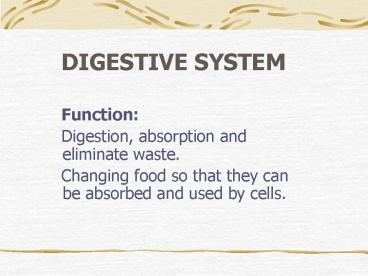DIGESTIVE SYSTEM - PowerPoint PPT Presentation
1 / 10
Title:
DIGESTIVE SYSTEM
Description:
Starch. Pancreatic juice (accessory) Protease (trypsin) Lipase. Amylase ... Starch. Saliva (accessory) Amylase (ptyalin) Resulting products. Enzyme digests ... – PowerPoint PPT presentation
Number of Views:43
Avg rating:3.0/5.0
Title: DIGESTIVE SYSTEM
1
DIGESTIVE SYSTEM
- Function
- Digestion, absorption and eliminate waste.
- Changing food so that they can be absorbed and
used by cells.
2
Type of Digestion
- Mechanical digestion
- Chewing, swallowing, peristalsis etc. break food
into tiny particles, mix them well with the
digestive juices and move them along the
digestive tract. - Chemical digestion
- Breaks down large food molecules into smaller
molecular by digestive enzymes.
3
Reference http//www.ama-assn.org/ama/pub/categor
y/7155.html
4
Digestion processes
- Mouth (mechanical and chemical digestion teeth
and salivary gland) - esophagus (mechanical peristalsis)
- stomach (chemical enzyme)
- small intestine (chemical enzyme)
- bile gallbladder liver
- pancreatic juice pancreas
- large intestine
5
(No Transcript)
6
Food
- Food is used as collections of nutrients in a
form which is eaten, digested and metabolized to
provide energy and materials that build and
maintain the structure, regulate the function of
the body. - Major nutritional sources
- Organic compounds carbohydrates
- proteins
- lipids
- vitamins
- Inorganic compound water H2O
- Minerals Na, K, P, S, Ca, Fe etc.
7
- Energy balance
- 3040 of energy are used for normal growth,
development and activity. The rest is used for
maintain body temperature. - Food and Nutrition Board recommend
- female 2,000 Kcal
- male2,700 Kcal
- 1Kcal energy required to raise the temperature
of 1 liter of H2O from 1516C - Energy producing food
- protein 4 Kcal/g
- carbohydrate 4 Kcal/g
- fat 9 Kcal/g
8
- Organic Compounds
- Carbohydrate
- suggest intake 50100 g/day
- primary energy source
- eg. Sugar, starch
- Lipid
- 6090 g/day
- fat containing compounds
- fat soluble vitamins A, D, E, K
- Vitamin A vision, bone, teeth, anticancer
- Vitamin D control optimal blood level of Ca, P
- Vitamin E antioxidant agent
- Vitamin K blood clot
- Essential fat (lipid) linoleic acid
9
- Proteins
- 4060 g/day, but in USA about 100 g/day
- Essential amino acid
- eg. Lysine, leucine, isoleucine and tryptophan
- Complete proteins from animal sources
- Incomplete proteins from plants
- eg. Peas and beans are good lysine source but low
in trptophan nuts, seeds and cereals are good
source in tryptophan but low in lysine - Complementary diet is important for vegetarians
10
Body Mass Index (BMI)
- BMI of 25 is ideal
- Less than 25 is great
- 30 and above is very unhealthy

